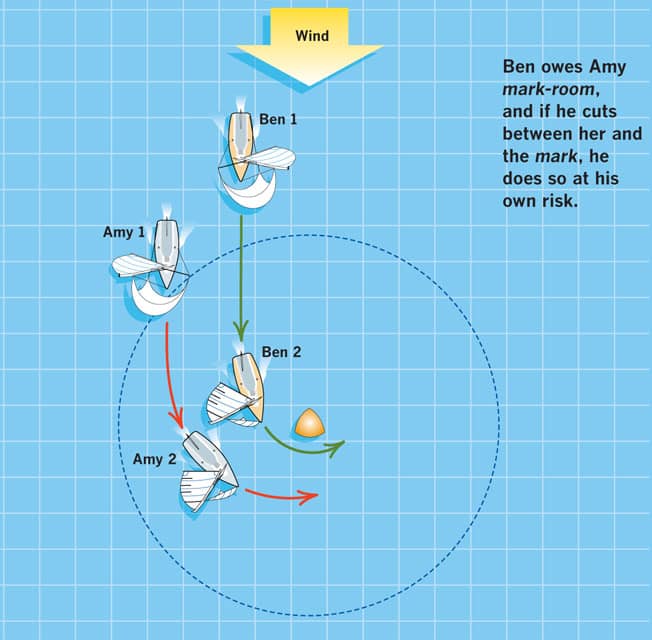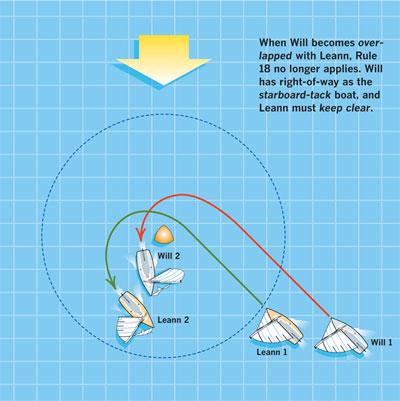
Mark Room 1
In the first installment of this series, I discussed what I judge to be the most significant change in the 2013 rules—the change in the definition Mark-Room. This month I explore the impact of a totally new rule within Rule 18, the mark-rounding rule. The new rule is Rule 18.2(c)(2), and the reasons for it are not obvious. I’ll give you some background and then explain how the new rule works.
The first diagram shows a common situation in which the new rule applies. Amy and Ben, sailing with their chutes set, are running toward the leeward mark, which they will leave to port. The next leg is a beat to windward. Amy is clear ahead when she reaches the zone (Position 1). Rule 18.2(b), therefore, requires Ben to give Amy mark-room, and later—at Position 2 when an overlap between them begins—Rule 18.2(c)(1) requires him to continue giving mark-room.
Amy’s crew has difficulties lowering the spinnaker, and at Position 2, a gap opens between Amy and the mark. Ben is tempted to dart through the gap. He thinks there’s no way Amy can get to him if he rounds inside her. For more than 50 years the rules have allowed a boat behind to round inside the boat ahead, provided the boat behind breaks no rule. ISAF Case 63 states that when a boat voluntarily or unintentionally makes space at a mark available to another boat that has no right to that space, the other boat may, at her own risk, take advantage of the space.
The questions that are inevitably asked are: “What course change can Amy make to shut the door on Ben? How do we decide when Ben has broken a rule?”
| Rule 18.2(c)(2): When a boat is required to give mark-room by Rule 18.2(b), if she becomes overlapped inside the boat entitled to mark-room, she shall also give that boat room to sail her proper course while they remain overlapped. |
New rule 18.2(c)(2), shown in the box, must be considered in answering these questions.
At Position 2, Amy has not yet “rounded the mark as necessary to sail the course,” and so Ben is still required to give her mark-room. At Position 2, Ben becomes overlapped inside Amy. Therefore, Rule 18.2(c)(2) applies. It entitles Amy “room to sail her proper course.” Note that this is in addition to the mark-room to which she is entitled under Rules 18.2(b) and 18.2(c)(1). Under these two rules Amy is entitled to room to round up to a close-hauled course (the course change necessary to sail the course). However, Rule 18.2(c)(2) entitles her to sail her proper course—an even stronger right than she gets under Rules 18.2(b) and 18.2(c)(1). Her proper course may well be to luff briefly above close-hauled to enable her to start the beat on a track to weather of any boats ahead or behind, thereby escaping the backwind effect from boats ahead, and maximizing the backwind she creates for boats astern.
So now we’ve answered our first question: Amy can luff, even above close-hauled on port tack, to shut the door on Ben. Note that as she does so, she has right of way under Rule 11 as the leeward boat, and she will be exonerated if, while taking room under Rule 18.2(c)(2) or mark-room under Rules 18.2(b) and 18.2(c)(1), she breaks rule 16.1 (see new Rule 21, Exoneration, which replaces the old exoneration rule, Rule 18.5). So Amy may luff as rapidly as she pleases. The only limitation on her is that she must comply with Rule 14 (Avoiding Contact). However, even if she were to make contact with Ben, she could be exonerated under Rule 14(b) provided there was no damage or injury. Clearly, the rules allow Amy to aggressively shut the door on Ben, and while doing so, if she must curtail her luff in order to avoid contact with Ben, then Ben breaks Rules 11 and 18.2(b). That is the criterion to apply to decide whether Ben breaks a rule while trying to take advantage of space made available while Amy’s crew wrestled with the spinnaker.

The second diagram illustrates another situation in which a boat that had been clear astern and required to give mark-room became overlapped inside the boat ahead. Leann and Will were both on starboard tack approaching a windward mark to be left to port, with Leann clear ahead when she reached the zone. The next leg was a run directly downwind. The boats rounded the mark as shown in the diagram, and just before Position 2, Leann jibed and luffed onto a broad reach on port tack. Her change of course after jibing created an overlap between her and Will.
The rules that apply between Leann and Will are quite different from those that applied between Amy and Ben. You might think that at Position 2, because Will just became overlapped inside Leann, that new Rule 18.2(c)(2) would apply. However, it does not, and here’s why: In order for that rule to apply, Will must still be required by Rule 18.2(b) to give Leann mark-room when the boats become overlapped. Certainly when Leann reached the zone she was entitled to mark-room under Rule 18.2(b). The definition Mark-Room states that she was entitled to (1) room to leave the mark to port, (2) room to sail to the mark, and (3) room to round the mark as necessary to sail the course. The rounding “necessary to sail the course” in this situation was the course change from a close-hauled course to a run. However, just before Position 2, when Leann completed her turn onto a run, she had received and taken advantage of the space given to her by Will for maneuvers (1), (2), and (3). Therefore, when she jibed and luffed, she was no longer entitled to mark-room from Will under Rule 18.2(b), nor was she entitled to room to sail her proper course under Rule 18.2(c)(2). So at Position 2, the only rules that applied were Rule 10, under which Leann, on port tack, was required to keep clear of Will, on starboard, and Rule 14, which required both boats to avoid contact if reasonably possible.
It’s obvious that at Position 2 Will needed to take action to avoid Leann, so Leann broke Rule 10. Normally, a boat that obtains right of way must, under Rule 15, “initially give the other boat room to keep clear.” However, Will obtained right of way because Leann jibed and luffed, and so Rule 15 did not apply because Will acquired right of way as a result of Leann’s actions.
If you study the definition Mark-Room, you’ll see it depends heavily on the definition Room. Mark-room is, as noted above, room to carry out three maneuvers (and, occasionally, a fourth maneuver—tacking). That room is always the space needed to carry out the maneuvers promptly. When a boat that is entitled to mark–room has been given the required space and enough time to promptly complete the maneuvers, she is no longer entitled to mark–room, and at that time, Rule 18.2(b) no longer applies to her.
There is an important general principle illustrated here: Once a boat entitled to room or mark–room has been given space to promptly complete all the maneuvers she is entitled to make, the rule entitling her to room or mark–room “switches off,” and only the rules of Sections A and B apply.









